Reproduction
How Tillandsia reproduces:
- vegetatively;
- in a generative way.
Children
Lateral shoots are called babies. Their intensive growth occurs during the period of full formation and opening of buds. One plant can give from three to eight daughter shoots.
Shoots with a hardened root system are planted separately. The soil is prepared from peat and sand mixed in equal proportions.
If only one baby has formed, then the faded plant is removed to make room for a daughter shoot. Young tillandsia will delight with flowers in two / three years.
Seeds
For germination of seeds, a moistened mixture of sand and peat is used. Seeds are scattered over the ground, without sprinkling on top. The container is covered with glass or foil and placed in a bright, warm place. Sprouts are formed after 25-30 days. Flowers appear only after five years.

Rooted tillandsia babies for reproduction
Common growing questions
Why doesn't the flower bloom?
A capricious plant, as a rule, reacts to inappropriate conditions of detention with a lack of flowering. Lack of moisture or light, sudden changes in temperature or drafts are the main reasons Tillandsia refuses to bloom.
What is the lifespan of a flower?
A flower grown indoors rarely lives more than 4-5 years. The life of a plant in captivity, as a rule, ends with its flowering, after which the mother rosette dies, leaving behind 1 or 2 young shoots.
How to stimulate flowering?
If the tillandsia has not released a peduncle for several years, you can stimulate its flowering with the help of treatment with growth regulators. To stimulate flowering, the most commonly used drug is Zircon. However, for flowering a plant, as a rule, high humidity and good lighting are quite enough.
Tillandsia is a tropical beauty who amazed many growers with her exotic and whimsical appearance. Growing a flower at home is not an easy task, but the result is worth it.
Popular types of tillandsia
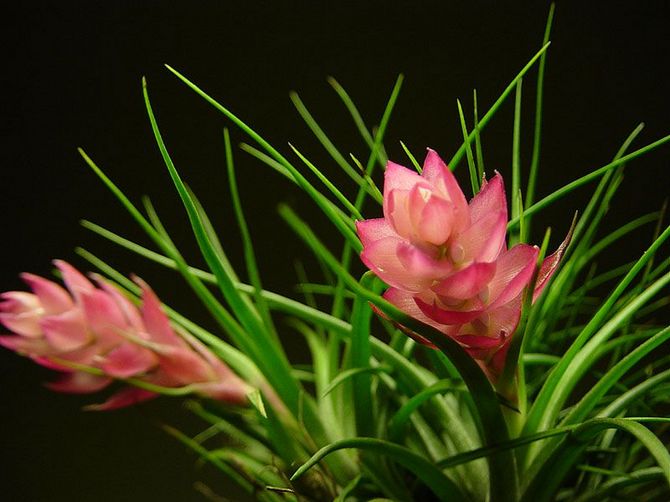
In nature, there are about 400 species of this plant. Only a few of them can be grown as a pot culture. Epiphytic plants are characterized by the absence of roots, therefore, stands made of wood, plastic or metal are sufficient for their successful cultivation. Watering in this case is replaced by regular spraying. Despite the fact that green tillandsias also have a poorly developed root system, they grow in the ground like ordinary houseplants. Of particular value in such species are bright spike-shaped inflorescences.
Tillandsia Anita
Perhaps the most popular variety of this plant. Bred as a Tallandsia blue hybrid, Anita is very decorative in appearance. Its scaly leaves are narrow and spiky. They form a rosette, in the center of which, on a short stem, there is a blue flower surrounded by pink or lilac bracts. Despite the fact that the flower fades quickly, its bracts remain bright for a long time, gradually turning green.
Tillandsia usneiform
Of the epiphytic tillandsia varieties, this one can most often be found in home premises. The leaves of this plant are in the form of threads, with scales and are gray in color, their length is about 5 centimeters. They hang down in a cascade, so it is convenient to grow them on stands. In such conditions, the leaves can reach 1 meter in length. In the people of Tillandsia, Usneiform is called Spanish moss or Old Man's Beard. It blooms in the warm season, but its flowers are not particularly attractive because of the faded yellowish or bluish color.
Tillandsia tricolor
The plant belongs to the green varieties. A dense rosette of Tillandsia tricolor is formed by thin twenty centimeter scaly leaves, rather narrow and pointed. The long stems of the peduncles are erect. On them are spikelets of inflorescences, sometimes even several of these spikelets. This flower got its name "tricolor" thanks to the multi-colored leathery sepals, which form a red-yellow-green inflorescence. The tillandsia flower itself is located on a long stem of 7 centimeters, has petals painted in purple. The plant blooms in the summer.
Tillandsia Flabellata
The rosette of this tillandsia resembles that of a tricolor tillandsia. The main decorative value in it is represented by bright orange-red bracts with an unusual tubular shape.
Transplanting and soil selection
Many growers make the mistake of replanting a flower immediately after purchase. If the tillandsia has a peduncle, let it bloom first - a transplant with a mature peduncle can negatively affect the viability of the plant.
An adult exotic flower is transplanted every 2-3 years. Exceptions are crop injury or disease when immediate soil replacement is required.
The pot should be shallow, of medium width. For the cultivation of exotics, a ready-made substrate for orchids is used. Alternatively, you can use a self-prepared soil mixture:
- sheet land - 1 part;
- peat - 1 part;
- chopped sphagnum moss - 1 part;
- crushed charcoal;
- river sand;
- humus;
- chopped spruce or fir bark.
The last four components are taken in minor proportions. Since the root of the flower is delicate and shallow, you need to be as careful as possible during transplanting. When burying the plant in a new substrate, try to avoid damaging the roots. At the end of the transplant, moisten the soil well and cover it with pieces of sphagnum.
Cattleya care at home
Transfer
Cattleya is transplanted after rest, if the pot becomes too small for the plant - about once every 3 years.
- Orchids prefer clay pots because their walls allow moisture and air to pass through.
- Dry, rotten and damaged roots are cut with a sharp pruner during transplantation, and the cuts are treated with crushed charcoal.
- Pseudobulbs are buried just as much as they were submerged in the soil in the previous pot.
- After planting, the soil around the plant is lightly tamped with your fingers to remove air pockets.
Freshly transplanted plants are shielded from sunlight and watering is limited for 4 to 5 days so that damaged roots do not rot.
When it blooms
Cattleyas can bloom almost all year round with proper care. The specific flowering time depends on the species.
The flowering period lasts up to 1.5 months.
Soil for cattleya
Based on sphagnum moss, fern roots and pine bark, loose, nutritious, with the addition of perlite to improve drainage. Add small pieces of charcoal to the finished mixture.
The soil must be air and moisture permeable.
As a drainage layer, it is not worth using expanded clay, but pieces of pine bark laid out on the bottom of the pot.
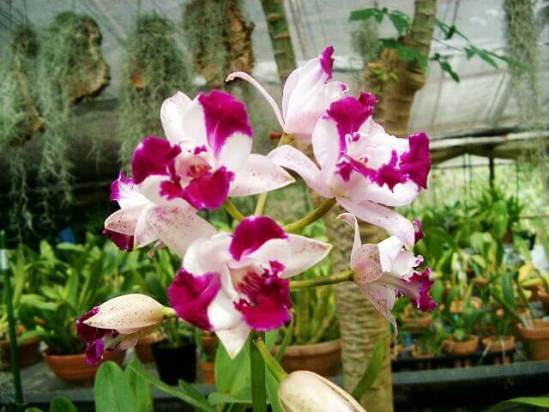
Watering
During the growth period, water it abundantly, but allow the soil to dry out before the next watering. After opening the buds, the soil is dried quite strongly, then the flowering will last longer.
After flowering, give the orchid a short rest period of 6 weeks and simply keep the pseudobulbs from shrinking.
The rest of the water from the sump must be drained.
For irrigation, use only softened water at room temperature or even slightly warmed up.
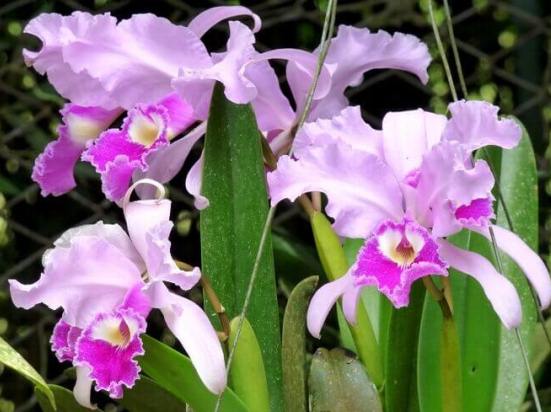
By dividing adult plants during transplantation.
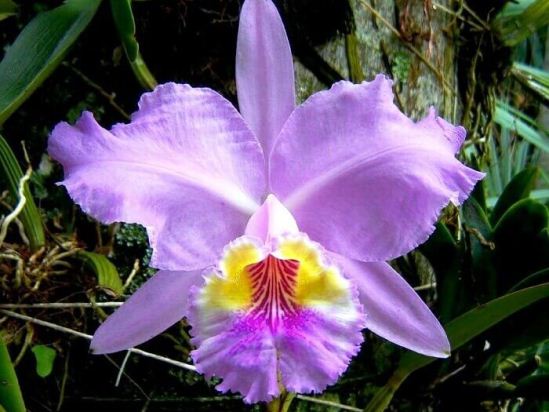
How to care
Cattleya is not the easiest orchid to care for, but all labor costs for its cultivation are paid off by the charm of its flowers.
Cattleya diseases and pests
- Plant rot occurs due to excess water.
- Too dry air can cause buds to fall off.
- Blooming will not occur in poor lighting conditions.
- When exposed to direct sunlight in the spring and summer daytime hours, brown spots may appear on the leaves - the orchid gets burned.
Insects - pests: spider mites, mealybugs, aphids, scale insects.
Insects are pests
| Insect name | Signs of infection | Control measures |
| Mealybug or felt insect | The surface of the leaves and shoots is covered with fluffy, cotton-like white bloom. Plants are lagging behind | Folk remedies: spraying with soap and alcohol solution. Infusion of tobacco, garlic, cyclamen tubers, alcohol treatments, pharmaceutical tincture of calendula proved to be good. Chemicals: green soap solution, Actellik, Fitoverm. |
| Spider mite | Subtle spider webs on the leaves, yellowing and foliage falling off with extensive lesions. The surface of the sheet plates becomes dead and covered with small cracks. Plant development slows down. | Folk ways. Plants can be rinsed in the shower and left in the bathroom in a humid atmosphere for half an hour. Irradiation with an ultraviolet lamp every week for 2 minutes. Chemical preparations based on pyrethrum, sulfur powders, Fitoverm, Actellik. |
| Aphid | Sticky droplets appear on the leaf plates, the leaf plates curl and deform, delicate buds and young leaves wither. Insect colonies can be seen on the tops of the shoots, buds or the underside of the leaf plates. The flowers of aphid-infested plants may become deformed. | Folk methods: infusion of nettle, decoction of rhubarb leaves, wormwood, soap solution, infusion of tobacco and dandelion, onions, marigolds, yarrow, tansy, dusting with dry ash. Chemical preparations: Sulfur powders, green mass treatment with green potash soap without getting into the ground, Decis, Aktellik, Fitoverm. |
| Shield and false shield | Sticky droplets on the leaves, small yellow spots on the surface of the leaf plates. With a large spread of scale insects, they contribute to the drying and falling of leaves. Flowers slow down their development | Folk methods of struggle. Spraying with soap and alcohol solution. Scabbard larvae do not like garlic infusion; they also use pyrethrum-based products. Chemicals. Fitoverm, Aktellik, Fufanon. |
-
Spider mite
-
Mealybug
-
Shield
-
Aphid
Tillandsia: home care
The culture is characterized by developed roots, so caring for Tillandsia Anita at home is not difficult.
Temperature
The plant is considered to be quite thermophilic. In the room, you need to maintain the temperature in the range of + 17-26 degrees. The culture does not perceive temperature fluctuations well, therefore it should be protected from drafts. This is especially true in winter. In summer, the flower can be taken out to the balcony.
Lighting
Culture requires not too bright ambient light. In spring and summer, it can be kept on the northern windowsill. In winter, there will be little light for the flower, so it must be transferred to the west or east window.
Watering
It is recommended to water the culture with soft water. It should be defended or boiled. To make the water softer, it is allowed to add lemon or vinegar to it. After watering, the soil should be moist, but not wet.
Important! When watering, it is recommended to pour water into a leaf outlet. It should stand for a while, after which the water should be drained.
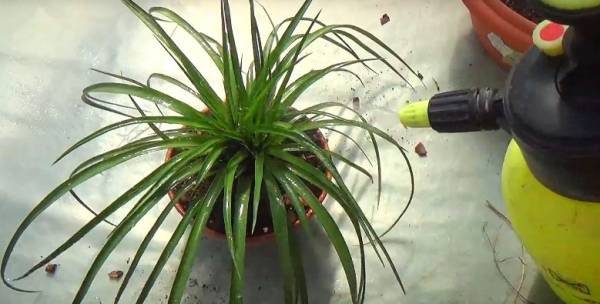
The plant needs to be watered correctly
Spraying
Periodically, leaf outlets must be sprayed. For this purpose, you should also use soft and settled water.
When flowering, the procedure is recommended to be carried out carefully so that water does not get on the peduncle.
Humidity
The plant needs optimal moisture parameters - at the level of 70-80%. During the heating season, the indicators should be increased artificially.To do this, you need to put the flower on a pallet with damp pebbles or use special household devices.
Priming
Growing a crop requires a special substrate. To make it, you need to mix in equal proportions leafy soil, sphagnum moss, chopped pine bark.
Top dressing
It is recommended to feed the plant with liquid fertilizer every 2 weeks. It is allowed to use the preparation for orchids. In this case, the dosage indicated on the package is recommended to be reduced by 2 times. The plant accepts foliar feeding well. It can be sprayed with a mild fertilizer solution.
Diseases and pests of tillandsia
Almost no typical indoor pests are scary for tillandsias. But they suffer very often from the bromelium scale, and serious lesions are possible on any type of tillandsia. You can fight this specific pest only by washing the plants with soapy water and removing the scutes from the leaves, which is not always possible in fragile epiphytic species.
Diseases threaten tillandsia in any violation of the conditions of detention. Rot and various viral infections are especially dangerous, and it is not enough to fight them with fungicides: the damaged parts of the plants will have to be cut out.
Common growing problems:
- rolling leaves when dehydrated;
- decay of the base of the outlet when fertilizing with water for irrigation.
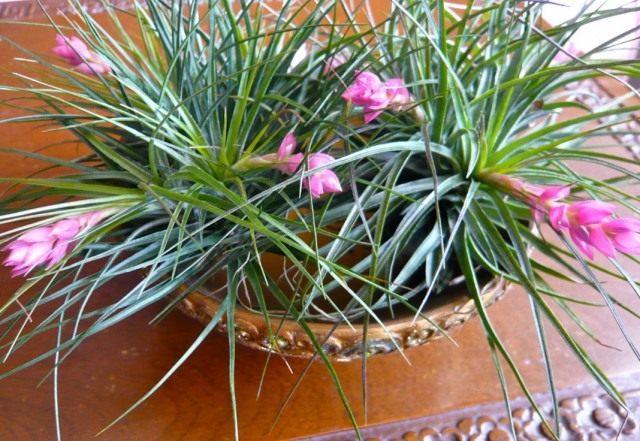 Tillandsia sticking out (Tillandsia stricta). Soul Train
Tillandsia sticking out (Tillandsia stricta). Soul Train
Tillandsia - home care
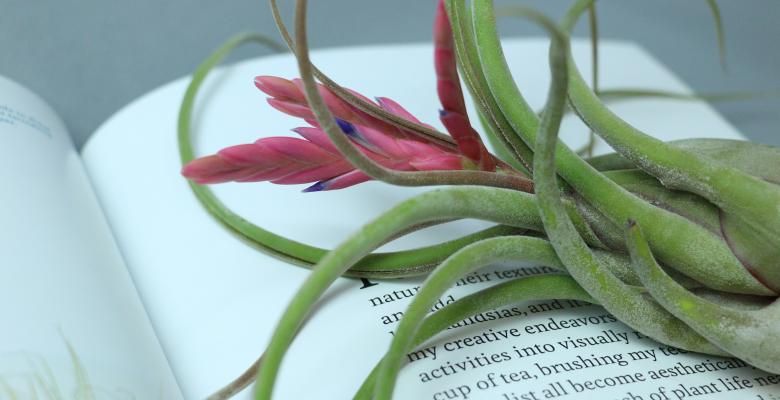
Tillandsia is an exotic plant of the bromeliad family. The genus got its name in honor of the botanist Ellias Tillands, who founded the Botanical Garden at the University of Helsinki.
The birthplace of the flower is America. In the wild, it lives in tropical areas - in Chile, Mexico, the southern part of the United States. In our area, it is grown only as a houseplant.
Tillandsia quickly adapts to climate variability, thanks to which it grows superbly in different climatic zones (savannah, mountainous areas, semi-desert).
Leaves are green or silvery. Bracts are pink, forming a spike-shaped inflorescence. Over time, flowers appear from them. Usually they are blue, blue, purple, but they can have other colors.
In some species, flowering lasts about two months, while in others, several days. Mostly exotic beauty blooms in summer, but can please with flowering at any other time of the year.
Most of the species are monocarpic. After flowering, the leaf rosette dies off, and they die. Tillandsia attracts not only with its decorative appearance. It improves energy, reduces noise and purifies the air.


